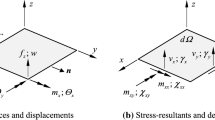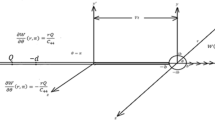Abstract
The coefficients of the crack tip asymptotic field of a typical wedge-splitting specimen are computed using a hybrid crack element (HCE), which has the potential to directly calculate not only the stress intensity factor (SIF) but also the coefficients of the higher order terms of the crack tip asymptotic field. The approximate closed-form expression for SIF proposed by Guinea et al. (1996) is calibrated by the results of the HCE. Approximate expressions for the second and third order terms for the wedge-splitting specimen are obtained by fitting the computed data. Numerical results show that the coefficients for terms higher than three are negligibly small, thus the wedge-splitting specimen is more stable than other geometries.
Similar content being viewed by others
REFERENCES
Bruhwiler, E. and Wittmann, F.H. (1990). The wedge-splitting test: a method of performing stable fracture mechanics tests. Engineering Fracture Mechanics 35, 117–125.
Du, Z.Z. and Hancock, J.W. (1991). The effect of non-singular stresses on crack tip constraint. Journal of the Mechanics and Physics of Solids 39, 555–567.
Guinea, G.V., Elices, M. and Planas, J. (1996). Stress intensity factors for wegde-splitting geometry. International Journal of Fracture 81, 113–124.
Karihaloo, B.L. (1995). Fracture Mechanics and Structural Concrete. Addison Wesley Longman, UK.
Karihaloo, B.L. (1999). Size effect in shallow and deep notched quasi-brittle structures. International Journal of Fracture 95, 379–390.
Karihaloo, B.L. and Xiao, Q.Z. (2001a). Accurate determination of the coefficients of elastic crack tip asymptotic field by a hybrid crack element with p-adaptivity. Engineering Fracture Mechanics 68, 1609-1630.
Karihaloo, B.L. and Xiao, Q.Z. (2001b). Higher order terms of the crack tip asymptotic field for a notched threepoint bend beam. International Journal of Fracture (in press).
Karstensen, A.D., Nekkal, A. and Hancock, J.W. (1997). The constraint of elastic-plastic crack tip fields. Advances in Fracture Research, Proceeding of ICF9 (Edited by B.L. Karihaloo, Y.W. Mai, M.I. Ripley and R.O. Ritchie), Pergamon, Oxford, 2007–2014.
Linsbauer, H.N. and Tschegg, E.K. (1986). Fracture energy determination of concrete with cube-shaped specimens. Zement und Beton 31, 38–40.
Muskhelishvili, N.I. (1953). Some Basic Problems of Mathematical Theory of Elasticity. Noordhoff, Holland (English translation).
Nikishkov, G.P. (1998). A fracture concept based on the three-term elastic-plastic asymptotic expansion of the near-crack tip stress field. Fracture: A Topical Encyclopedia of Current Knowledge (Edited by G.P. Cherepanov), Malabar, Krieger Pub Co, Florida, 557–574.
O'Dowd, N.P. and Shih, C.F. (1991). Family of crack-tip fields characterized by a triaxiality parameter: Part I – structure of fields. Journal of the Mechanics and Physics of Solids 39, 939–963.
Owen, D.R.J. and Fawkes, A.J. (1983). Engineering Fracture Mechanics: Numerical Methods and Applications. Pineridge Press Ltd., Swansea, U.K.
Pian, T.H.H. and Sumihara, K. (1984). Rational approach for assumed stress finite elements. International Journal for Numerical Methods in Engineering 20, 1685–1695.
Pian, T.H.H. and Wu, C.C. (1988). A rational approach for choosing stress term of hybrid finite element formulations. International Journal for Numerical Methods in Engineering 26, 2331–2343.
Sih, G.C. and Liebowitz, H. (1968). Mathematical theories of brittle fracture. In Fracture-An Advanced Treatise (Edited by H. Liebowitz), II, Academic Press, New York, 67–190.
Tong, P., Pian, T.H.H. and Lasry, S.J. (1973). A hybrid element approach to crack problems in plane elasticity. International Journal for Numerical Methods in Engineering 7, 297–308.
Tschegg, E.K. and Linsbauer, H.N. (1986). Test Method for the Determination of Fracture Mechanics Properties. Patent specification No. A-233/86 390 328, Austrian Patent Office.
Tschegg, E.K. (1990). Patent specification No. A-408/90, Austrian Patent Office.
Williams, M.L. (1957). On the stress distribution at the base of a stationary crack. Journal of Applied Mechanics 24, 109–114.
Xiao, Q.Z., Karihaloo, B.L. and Williams, F.W. (1999). Application of penalty-equilibrium hybrid stress element method to crack problems. Engineering Fracture Mechanics 63, 1–22.
Author information
Authors and Affiliations
Rights and permissions
About this article
Cite this article
Karihaloo, B., Xiao, Q. Higher order terms of the crack tip asymptotic field for a wedge-splitting specimen. International Journal of Fracture 112, 129–137 (2001). https://doi.org/10.1023/A:1013366025494
Issue Date:
DOI: https://doi.org/10.1023/A:1013366025494




